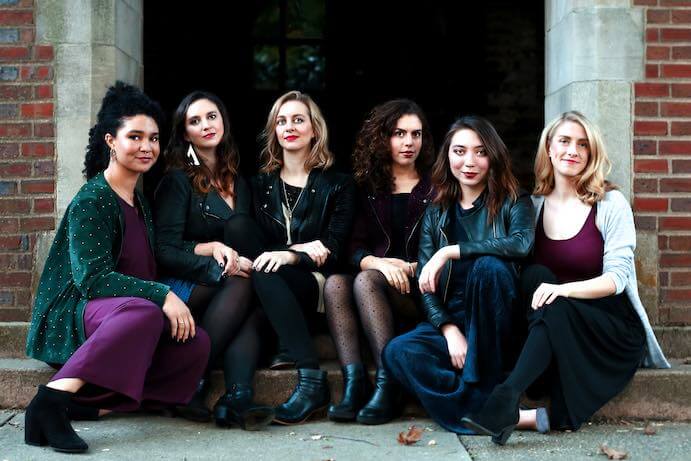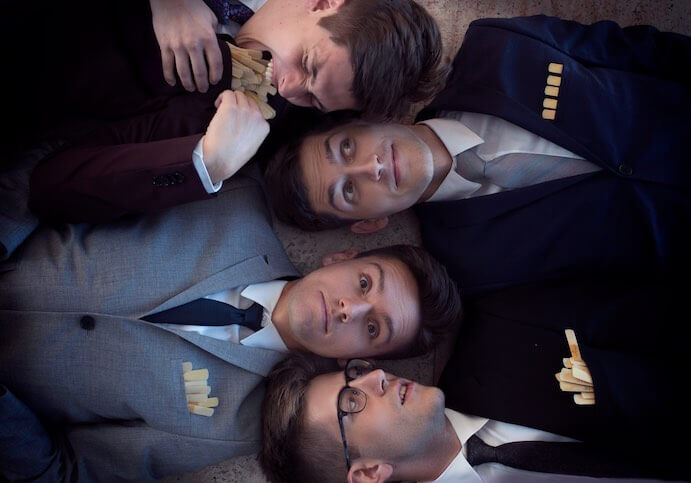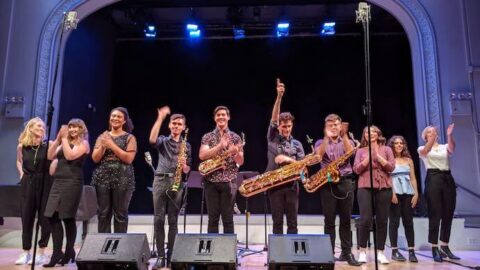Chicago-based ~Nois is not a noise music ensemble, nor are they an electronic or computer-based band, as users of the software Max/MSP might expect (“~nois” is a command therein)–but they do execute with exacting precision and confident command. The ~Nois boys are Brandon Quarles, Jordan Luloff, János Csontos, and Hunter Bockes, a saxophone quartet dedicated to expanding and redefining the repertoire. On October 24, 2019, they brought their savvy and finesse to New York City, filling the ballroom hall of Brooklyn’s Roulette Intermedium with their brazen, brand new sounds.
~Nois presented a set of commissions from the US-based collective Kinds of Kings, a group of six composers–Emma O’Halloran, Susanna Hancock, Maria Kaoutzani, Finola Merivale, Gemma Peacocke, and Shelley Washington–that focuses on amplifying and advocating for under-heard voices in the music world. According to founding member Gemma Peacocke, Kinds of Kings is “a celebration of creativity and individuality.” This ideology was not only reflected in the variety of musical voices on the program, but also animated the space itself: each individual composer felt celebrated by their friends, fans, collaborators, and fellow composers who showed up to Roulette that evening.

The first piece, Night Music by Emma O’Halloran, would resonate with any urban American audience as it is evocative of a traffic jam turned celebration (think La La Land, minus the camp). Tightly stacked saxophones take turns with a plaintive melody while the rest buzz around it, like a democratic swarm of bees. Yet the blueprint of Night Music is ascending major seventh chords streaming through the quartet, a beautiful effect that conjures a waterfall in reverse. Hiatus by Susanna Hancock takes the same chord, darkens it, and kicks it into high gear. The thematic major seven from the previous piece became a minor seven, and suddenly the saxophone’s history and place in jazz music became apparent. Particularly enjoyable in this piece are the rapid polar shifts between clamor and suspense–or perhaps hiatus?–and a four-layer polyrhythm, expertly cut by ~Nois, that created a mirage effect.
A shore to a shore by Maria Kaoutzani sounded like old, rusty machines being run by ghosts, or ~Nois speaking softly in tongues (as saxophones quartets literally do). Breaking through the murmuring microtonal texture, multi-phonics (pitches split into a rainbow of frequencies) appear like sunlight on the surface of a dark, cold and unknown planet. Melismatic material gives way to a chant theme: a rewarding and yet uneasy closure.
In BIG Talk by Shelley Washington, the composer took the stage alone to recite a poem that addressed perpetrators of sexual assault. The members of ~Nois waited in the wings while Janós Csantos underwent a costume change and reappeared in a fishnet shirt and high heels to applause. The music, written for two baritone saxophones, carries a heavy anger. The two dueled and bubbled like a cauldron of rage. Washington kept us engaged and uneasy–BIG Talk unspools riff after riff with mid-stride meter changes.

Kenopsia by Finola Merivale has an alluringly dense texture that most prominently includes the catalog of extended saxophone techniques–clicks, slaps, and breaths–and a nicely varied, idiomatic structure. Its sonic images felt prone to the human form, with lurches, lunges, waves, and stretches in groups of fives and sevens. I would love to see this piece choreographed.
Then, all went black, and ~Nois’ horns were illuminated with LED rings: neon green, pink, blue, and dark green from left to right. Almost imperceptibly from where I was sitting, a slow-moving black and white film played on a screen behind the quartet. Gemma Peacocke’s Dwalm proceeded with humming, heat-wave-like chords that blossomed into trills and horn blasts before finally opening up into fantastical and varied themes. The group tossed around a tight riff, as though they were trying to unbox it, and at the end, as a last hurrah, the colored LED’s came from above and danced all over the stage. A celebration, indeed.
























